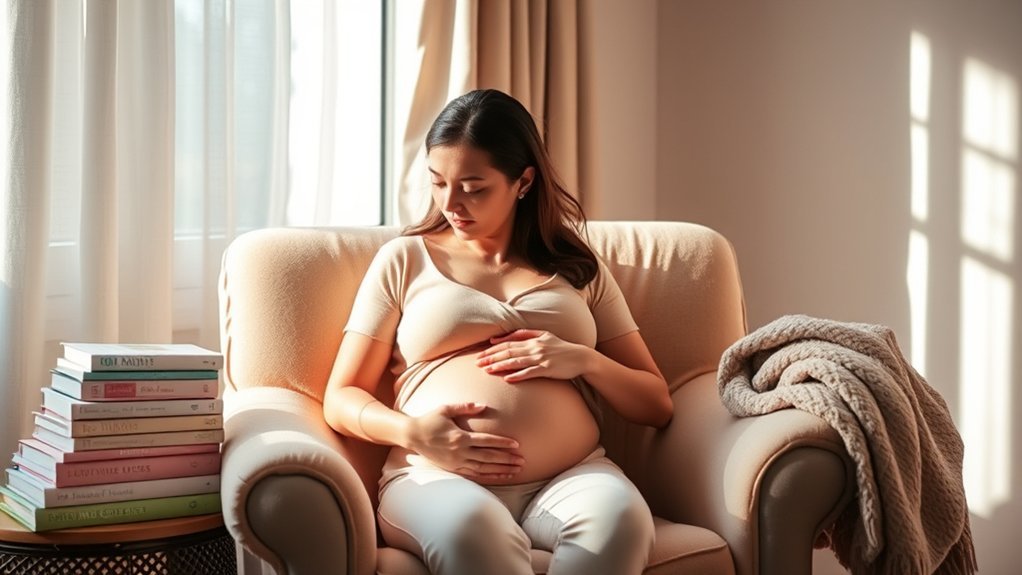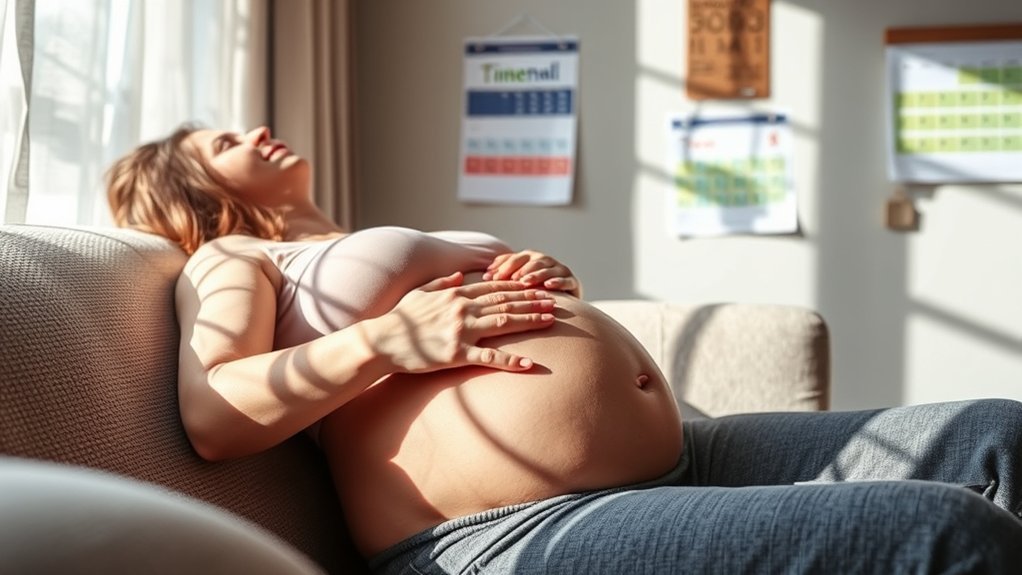If you’re experiencing Braxton Hicks contractions, it’s important to understand what they are and how they differ from true labor. These practice contractions can start as early as 20 weeks and may cause some confusion. You might wonder how to recognize them or when to seek help. Understanding these aspects can help you navigate your pregnancy more confidently. Let’s explore the key questions surrounding Braxton Hicks and clarify their role in your journey.
What Are Braxton Hicks Contractions?

Braxton Hicks contractions, often referred to as “practice contractions,” are sporadic tightening sensations in the uterus that can occur during pregnancy. They typically begin in the second trimester and become more noticeable as you approach your due date.
Unlike true labor contractions, these sensations don’t indicate that labor is imminent. You might experience them intermittently, sometimes triggered by physical activity, dehydration, or stress.
Braxton Hicks contractions are not a sign of impending labor; they can occur intermittently due to various triggers.
While they can be uncomfortable, they’re usually not painful and won’t result in cervical dilation. Understanding their purpose can help you differentiate between Braxton Hicks and actual labor contractions, allowing you to better manage your pregnancy experience.
Monitoring these contractions can provide reassurance that your body is preparing for the upcoming changes.
How Do Braxton Hicks Contractions Feel?

These practice contractions can feel like a tightening or hardening of the abdomen, often described as a sensation similar to a muscle cramp.
You might notice that they occur sporadically, usually becoming more frequent as your pregnancy progresses. Unlike true labor contractions, Braxton Hicks contractions are generally mild and don’t increase in intensity or frequency over time.
They can last anywhere from 30 seconds to two minutes and may subside with movement or changes in position. Some women report feeling them more when they’re active, dehydrated, or after a long day.
While they can be uncomfortable, they’re usually not painful and don’t indicate any complications. Always consult your healthcare provider if you have concerns about your symptoms.
When Do Braxton Hicks Contractions Start?

Braxton Hicks contractions typically start during the second trimester, but you may notice them becoming more frequent as your pregnancy progresses.
The timing can vary considerably depending on your individual pregnancy stage.
These contractions often differ in frequency and duration, so understanding these patterns is essential for recognizing what’s normal for you.
Typical Onset Timing
Although many expectant mothers may not notice them at first, Braxton Hicks contractions typically begin in the second trimester, around 20 weeks of pregnancy.
These contractions are often described as a tightening sensation in the abdomen and can vary in intensity. You might experience them sporadically throughout the day, especially with increased physical activity or dehydration.
It’s essential to understand that Braxton Hicks contractions are usually irregular and don’t signify the onset of labor.
As your pregnancy progresses, you may notice these contractions becoming more frequent, particularly in the third trimester.
Recognizing the difference between Braxton Hicks and true labor contractions can help alleviate anxiety as you approach your delivery date.
Always consult your healthcare provider if you have concerns.
Variations by Pregnancy Stage
As you progress through your pregnancy, the experience of Braxton Hicks contractions can vary considerably between stages. Typically, these contractions start in the second trimester, but their frequency and intensity may change as you near your due date.
| Pregnancy Stage | Onset of Contractions | Characteristics |
|---|---|---|
| First Trimester | Rarely experienced | Not usually felt |
| Second Trimester | 16-28 weeks | Mild, infrequent |
| Third Trimester | 28 weeks and beyond | More frequent, can be strong |
| Near Labor | Weeks leading up | Intensity increases, rhythmic |
Understanding these variations helps you differentiate between Braxton Hicks and true labor contractions, ensuring you feel more prepared for your birthing experience.
Frequency and Duration
Understanding the frequency and duration of Braxton Hicks contractions is vital for expecting parents. These practice contractions typically begin in the second trimester but may become more noticeable in the third trimester.
The frequency can vary widely; some women experience them infrequently, while others may feel them several times a day. Generally, Braxton Hicks contractions last between 30 seconds to two minutes.
Unlike true labor contractions, they’re irregular and often subside with activity or hydration. If you notice a pattern or increasing intensity, it’s important to consult your healthcare provider, as this could indicate the onset of labor.
Monitoring these contractions helps you differentiate between practice and actual labor signs, ensuring you’re prepared for your baby’s arrival.
How Long Do Braxton Hicks Contractions Last?
How long do Braxton Hicks contractions last? Typically, these contractions can vary in duration, but they generally last anywhere from 30 seconds to 2 minutes.
Here’s a quick breakdown:
- Initial Duration: They may start as short, lasting around 30 seconds.
- Gradual Increase: Over time, you might notice them lasting up to 2 minutes.
- Frequency: They can occur sporadically, sometimes several times an hour.
- Irregular Timing: Unlike true labor, their timing isn’t consistent or progressively closer together.
How Can You Distinguish Braxton Hicks From True Labor?
When trying to tell Braxton Hicks contractions apart from true labor, it’s essential to pay attention to specific characteristics.
Braxton Hicks are often irregular, infrequent, and usually don’t increase in intensity or frequency over time. You might notice that they ease with movement or hydration.
In contrast, true labor contractions typically become progressively stronger, more regular, and closer together. They often persist regardless of changes in position or activity.
Additionally, true labor may be accompanied by other signs, such as the breaking of the water or a bloody show.
Monitoring these differences can help you determine whether you’re experiencing Braxton Hicks or true labor, ensuring you respond appropriately as your delivery approaches.
What Triggers Braxton Hicks Contractions?
Braxton Hicks contractions can be triggered by various factors, including your physical activity levels and hydration status.
If you’re physically active or dehydrated, you may notice these practice contractions more frequently.
Understanding these triggers can help you manage and differentiate them from true labor signs.
Physical Activity Levels
While engaging in physical activity, many expectant mothers may notice the onset of Braxton Hicks contractions. These contractions can occur as your body prepares for labor, often triggered by various levels of exertion.
Here are some common activities that might provoke them:
- Walking – A brisk walk can stimulate uterine activity.
- Exercise – Engaging in moderate workouts may lead to contractions.
- Housework – Tasks like vacuuming or lifting can trigger Braxton Hicks.
- Sexual Activity – Physical intimacy can also induce these contractions.
Understanding your body’s responses during these activities can help you differentiate between Braxton Hicks and true labor contractions.
If you experience any concerns, consult your healthcare provider for guidance.
Dehydration and Hydration
Dehydration can greatly influence the occurrence of Braxton Hicks contractions, as your body may respond to insufficient fluid intake by tightening the uterine muscles. This tightening can be mistaken for actual labor contractions.
Staying well-hydrated is essential for your overall health and can help minimize these practice contractions. When you’re adequately hydrated, your body functions more efficiently, reducing unnecessary muscle tension.
Aim to drink sufficient fluids throughout the day, especially during hot weather or after exercise. If you notice an increase in Braxton Hicks contractions, consider your hydration levels.
Are Braxton Hicks Contractions Painful?
What exactly does it feel like when experiencing Braxton Hicks contractions? These contractions can be uncomfortable, but they’re usually not painful. You might notice sensations that vary in intensity, and they can feel different from actual labor.
Here are some common characteristics:
- Tightening: You’ll feel a firming of the abdomen that can last for 30 seconds to 2 minutes.
- Irregularity: They don’t come at regular intervals like true labor contractions.
- Relief with Movement: Changing positions or walking may ease the sensations.
- No Progression: Unlike labor contractions, Braxton Hicks don’t lead to cervical dilation.
While they can be surprising, rest assured that they’re a normal part of pregnancy and usually not a cause for concern.
When Should You Contact Your Healthcare Provider?
When should you reach out to your healthcare provider regarding Braxton Hicks contractions?
If you experience contractions that become regular, intense, or painful, it’s vital to consult your provider.
Additionally, if you notice any accompanying symptoms such as vaginal bleeding, fluid leakage, or a decrease in fetal movement, contact your healthcare provider immediately.
Another reason to reach out is if you’re less than 37 weeks pregnant and having contractions that seem to follow a pattern or increase in frequency.
It’s important to differentiate between Braxton Hicks and true labor contractions, so don’t hesitate to seek professional advice if you’re unsure about your symptoms.
Your healthcare provider can provide the best guidance tailored to your situation.
Tips for Managing Braxton Hicks Contractions
Although Braxton Hicks contractions are a normal part of pregnancy, managing them effectively can help alleviate discomfort. Here are some tips to contemplate:
- Stay Hydrated: Drink plenty of water, as dehydration can trigger contractions.
- Change Positions: Shifting from sitting to standing or lying down can relieve tension and reduce contractions.
- Practice Relaxation Techniques: Deep breathing, meditation, or gentle yoga can help ease discomfort and promote relaxation.
- Take Breaks: Resting frequently throughout the day can minimize fatigue and reduce the frequency of contractions.
Frequently Asked Questions
Can Braxton Hicks Contractions Occur During the First Trimester?
Yes, you can experience Braxton Hicks contractions during the first trimester, although they’re less common at this stage. These practice contractions help prepare your body for labor but shouldn’t be painful or rhythmic.
Are Braxton Hicks Contractions a Sign of Labor?
Braxton Hicks contractions aren’t signs of labor; they’re practice contractions that prepare your body. While they can occur throughout pregnancy, they typically don’t indicate that you’re approaching labor or delivery.
Do Braxton Hicks Contractions Affect Fetal Health?
Braxton Hicks contractions don’t negatively affect fetal health. They’re natural practice contractions, helping your body prepare for labor. However, if you experience significant discomfort or changes, consult your healthcare provider for personalized advice.
Can Stress Worsen Braxton Hicks Contractions?
Yes, stress can worsen Braxton Hicks contractions. When you experience stress, your body releases hormones that may trigger these practice contractions. Managing stress through relaxation techniques can help reduce their frequency and intensity.
Are There Any Long-Term Effects of Braxton Hicks Contractions?
No, Braxton Hicks contractions don’t typically cause long-term effects on you or your baby. They’re a normal part of pregnancy, signaling your body’s preparation for labor, but they won’t impact your health beyond that.
Conclusion
In conclusion, Braxton Hicks contractions are a normal part of pregnancy, serving as your body’s way of preparing for labor. While they can be surprising, they’re usually harmless and can often be managed through hydration and movement. However, if you experience regular or painful contractions, don’t hesitate to reach out to your healthcare provider. Remember, even the most minor discomfort can feel like an avalanche when you’re expecting, so stay informed and proactive about your health.
